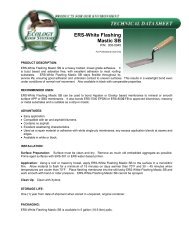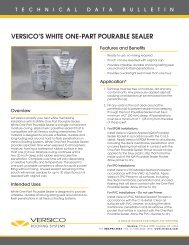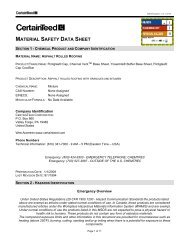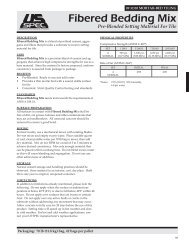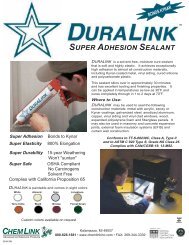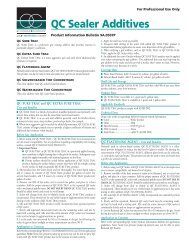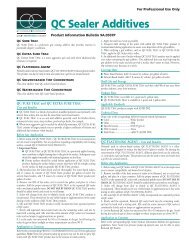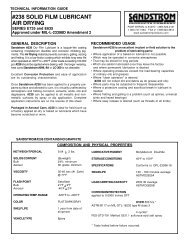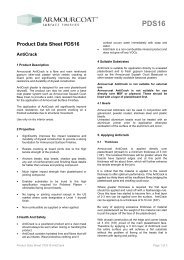Simpson Anchors - Anchoring and Fastening Systems - BuildSite.com
Simpson Anchors - Anchoring and Fastening Systems - BuildSite.com
Simpson Anchors - Anchoring and Fastening Systems - BuildSite.com
Create successful ePaper yourself
Turn your PDF publications into a flip-book with our unique Google optimized e-Paper software.
F-SAS-CSAS2009 ©2011 <strong>Simpson</strong> Strong-Tie Company Inc.<br />
<strong>Anchoring</strong> <strong>and</strong> <strong>Fastening</strong> <strong>Systems</strong> for Concrete <strong>and</strong> Masonry Addendum<br />
Torq-Cut Self-Undercutting Anchor for Cracked <strong>and</strong> Uncracked Concrete<br />
The Torq-Cut self-undercutting anchor is a heavy-duty, high-capacity anchor designed <strong>and</strong><br />
tested for use in cracked <strong>and</strong> uncracked concrete under static <strong>and</strong> seismic loading conditions.<br />
It is designed to meet the stringent requirements of the 2006 <strong>and</strong> 2009 IBC for post-installed<br />
anchors. The built-in ring with hardened cutters exp<strong>and</strong>s with installation torque forming<br />
undercut grooves in the concrete. This interlocking connection between the anchor <strong>and</strong> the<br />
concrete provides superior load carrying capacity.<br />
FEATURES:<br />
• Self-undercutting feature provides higher load carrying capacity than conventional mechanical<br />
anchors<br />
• AC193 code tested to ensure outst<strong>and</strong>ing performance in both cracked <strong>and</strong> uncracked concrete<br />
• Excellent for resisting seismic <strong>and</strong> vibratory loads<br />
• Suitable for seismic applications categories A-F<br />
• Ductile steel rod provides consistent, reliable performance<br />
• Specially designed, low-friction expansion cone minimizes binding <strong>and</strong> speeds installation<br />
• Installs just like a conventional expansion anchor, no special tool, drill bit, or secondary<br />
drilling is required<br />
• The head is stamped with the <strong>Simpson</strong> Strong-Tie ® "≠" sign <strong>and</strong> size identification for easy<br />
post installation verification<br />
MATERIAL: ASTM A193 grade B7 or B7M rod with SAE J403 grade 1144 undercut expansion ring<br />
<strong>and</strong> expansion cone<br />
FINISh: Zinc plated CODES: ICC-ES pending<br />
The load tables list values based upon results from the most recent testing <strong>and</strong> may not<br />
relect those in current code reports. Where additonal local jurisdiction requirements apply,<br />
consult the current reports for applicable load values.<br />
TEST CRITERIA: The Torq-Cut anchor has been tested in accordance with ICC-ES's Acceptance<br />
Criteria for Mechanical <strong>Anchors</strong> in Concrete Elements (AC193) <strong>and</strong> ACI 355.2 for the following:<br />
• Static tension <strong>and</strong> shear loading in cracked <strong>and</strong> uncracked concrete<br />
• Seismic <strong>and</strong> wind loading in cracked <strong>and</strong> uncracked concrete<br />
• Performance in cracked concrete<br />
Torq-Cut Setting Tool<br />
The TCAST is the steel setting tool used to install the Torq-Cut anchor. It is used to drive the<br />
anchor into the pre-drilled hole <strong>and</strong> protect the threads on the Torq-Cut from being damaged by<br />
hammer blows.<br />
INSTALLATION:<br />
Caution: Oversized holes in the base material will make it dificult to set the anchor <strong>and</strong><br />
will reduce the anchor’s load capacity. Do not use an impact wrench to set or tighten the<br />
Torq-Cut anchor.<br />
Installation Instructions: Pre-Set Version<br />
1. Drill a hole in the base material to the specified embedment depth using the appropriate<br />
diameter carbide drill bit specified for each diameter.<br />
2. Blow the hole clean using <strong>com</strong>pressed air.<br />
3. Assemble the anchor with nut <strong>and</strong> washer <strong>and</strong> finger tighten nut so all <strong>com</strong>ponents are snug<br />
(spacer sleeve, expansion sleeve <strong>and</strong> cone). The bottom of the threaded rod should be flush<br />
with the bottom of the cone.<br />
4. Place the anchor into the drilled hole <strong>and</strong> use a hammer <strong>and</strong> setting tool to drive the anchor<br />
until the washer <strong>and</strong> nut are tight against the surface of the base material.<br />
5. Remove the nut <strong>and</strong> washer <strong>and</strong> install the fixture. Re-assemble the nut <strong>and</strong> washer over the fixture.<br />
6. Tighten to the required installation torque.<br />
Installation Instructions: Through-Set Version<br />
1. Drill a hole in the base material to the specified embedment depth using the appropriate<br />
diameter carbide drill bit specified for each diameter.<br />
2. Blow the hole clean using <strong>com</strong>pressed air.<br />
3. Assemble the anchor with nut <strong>and</strong> washer <strong>and</strong> finger tighten nut so all <strong>com</strong>ponents are snug<br />
(spacer sleeve, expansion sleeve <strong>and</strong> cone). The bottom of the threaded rod should be flush<br />
with the bottom of the cone.<br />
4. Place the anchor through the fixture <strong>and</strong> into the drilled hole. Use a hammer <strong>and</strong> setting tool<br />
to drive the anchor until the washer <strong>and</strong> nut are tight against the fixture.<br />
5. Tighten to the required installation torque.<br />
AppLICATION: Interior environment where low levels of moisture <strong>and</strong> corrosive chemicals are present<br />
SUggESTED SpECIFICATIONS:<br />
Self-undercutting anchors shall have an expansion ring with undercutting teeth which exp<strong>and</strong>s by<br />
tightening the nut that pushes the ring into a cone exp<strong>and</strong>er via a spacer sleeve. The anchor shall<br />
have been tested <strong>and</strong> qualiied for performance in cracked <strong>and</strong> uncracked concrete per ACI 355.2<br />
<strong>and</strong> ICC-ES AC193. Undercut anchor shall be the Torq-Cut self-undercutting anchor from<br />
<strong>Simpson</strong> Strong-Tie, Pleasanton, CA, <strong>and</strong> be installed following the <strong>Simpson</strong> Strong-Tie instructions.<br />
TESTED<br />
TO<br />
MEET<br />
Torq-Cut <br />
Self-Undercutting Anchor<br />
U.S. patent 7,357,613<br />
Installation Sequence<br />
Steps 4, 5, 6 – pre-Set Version<br />
4 5 6<br />
Setting<br />
Tool<br />
Steps 4, 5 – Through-Set Version<br />
4 5<br />
Setting<br />
Tool<br />
���� Æ<br />
���<br />
����������<br />
Torq-Cut Anchor Installation Data<br />
Nominal Anchor Dia (in) ⁄ ⁄ ⁄ ⁄<br />
Drill Bit Size (in) ⁄ 7 ⁄ 1 1 ⁄<br />
Min. Fixture Hole Dia<br />
Pre-Set (in)<br />
Min. Fixture Hole Dia<br />
Through-Set (in)<br />
Torq-Cut <br />
Setting Tool<br />
(Sold separately)<br />
Steps 1, 2, 3 – pre-Set <strong>and</strong> Through-Set Version<br />
1 2 3<br />
⁄ 6 ⁄ 6 ⁄ ⁄<br />
⁄ 6 ⁄ ⁄ 1 ⁄<br />
Wrench Size (in) ⁄ 6 ⁄4 ⁄ 1 ⁄<br />
Setting Tool Required TCAST37 TCAST50 TCAST62 TCAST75<br />
13



